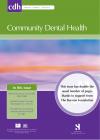Community Dental Health

- Cover Date:
- March 2011
- Print ISSN:
- 0265 539X
- Vol:
- 28
- Issue:
- 1
The dilemma of selecting suitable proximal carious lesions in primary molars for restoration using ART technique.
Objective: To determine the examiner’s accuracy in selecting proximal carious lesions in primary molars for restoration using the atraumatic restorative treatment (ART) approach. Basic research design: Intervention study. Clinical setting and participants: A total of 804 six to eight year-olds from 30 rural schools in Kenya participated in the study. Intervention: Three examiners selected a total of 1,280 suitable proximal carious lesions in primary molars after examining 6,002 children from 30 schools randomly selected out of 142 schools in two divisions. Seven operators randomly paired on a daily basis with eight assistants restored the lesions. An explanation was provided for any cavity that was not restored. Pre-and post-operative radiographs of the cavities were also taken for evaluation. Main outcome measures: The examiner’s choice of suitable proximal cavities restorable using the ART approach was related to the decision made to either restore or not during the operative stage. The radiographic findings of the selected cavities were also compared to the decision made by the operator. The results obtained were used to determine the examiner’s accuracy in selecting suitable proximal cavities for restoration using the ART approach. Results: The majority of the children recruited in the study were excluded due to absenteeism, pulpal-exposure or anxiety during the operative stage. Only 804 children received one restoration in their primary molars. The examiner’s accuracy in selecting suitable ART-restorable cavities clinically was 94.9% and based on radiographic analysis was 91.7%. Conclusions: A trained and diligent examiner has a very good chance of selecting proximal carious lesions restorable with the use of ART approach, without the threat of dental pulpal-involvement during the excavation of caries.
Key words: ART, cavity selection accuracy, primary molars, proximal lesions.
- Article Price
- £15.00
- Institution Article Price
- £
- Page Start
- 12
- Page End
- 16
- Authors
- A.M. Kemoli, W.E. van Amerongen
Articles from this issue
- Title
- Pg. Start
- Pg. End
- The caries experience of 5 year-old children in Scotland, Wales and England in 2007-2008 and the impact of consent arrangements. Reports of co-ordinated surveys using BASCD criteria
- 5
- 11
- The dilemma of selecting suitable proximal carious lesions in primary molars for restoration using ART technique.
- 12
- 16
- Using laser fluorescence (DIAGNOdent) in surveys for the detection of noncavitated occlusal dentine caries
- 17
- 21
- The prevalence of and risk factors for non-carious cervical lesions in adults in Hubei Province, China
- 22
- 28
- Health-related lifestyle behaviours, socio-demographic characteristics and use of dental health services in Greek adults.
- 47
- 52
- Periodontal health and treatment needs among hospitalized chronic psychiatric patients in Istanbul, Turkey
- 69
- 74
- Comparison of the COHIP and OHIP- 14 as measures of the oral health-related quality of life of adolescents
- 82
- 88
- Assessment and comparison of periodontal status among young smokers and nonsmokers of Bangalore, India - a cross sectional study.
- 89
- 94
- Smoking and drinking habits and attitudes to smoking cessation counselling among Tanzanian dental students
- 95
- 98
- Traumatic dental injuries to primary incisors and the terminal or occlusal plane relationship in Indian preschool children
- 104
- 106
- Teaching dental public health to undergraduates using community profiles and patient case studies
- 116
- 120
